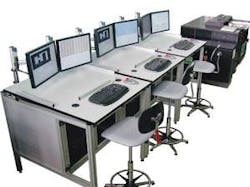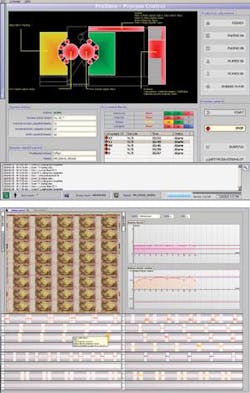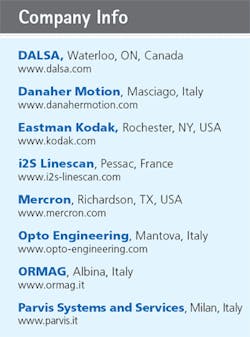Money in the Bank
Vision system inspects bank notes with color linescan camera, custom lens, and innovative lighting
Bank-note production is becoming increasingly more complex, particularly in Europe where euro notes are printed in multiple locations but must still conform to a single set of stringent printing requirements. Today’s currency also includes sophisticated security features such as embedded magnetic strips and multiple printing processes that must be checked against international euro currency standards.
The measure of bank-note quality is not simply a question of appearance or national clean note policy, but also the capability of automatic equipment to efficiently process currency transactions. The cash cycle is increasingly centered on automatic equipment depending on machine-readable features, which consequently must be printed within tight specifications and tolerances. These circumstances have created a scenario where front-end process optimization and control has replaced the traditional focus on back-end gross-error detection, final inspection, out sorting, and associated waste.
Bank-note quality has traditionally been determined by means of manual visual inspection at key steps in the printing process, but manual inspection leads to error. In response to new euro quality regulations and printing guidelines, Parvis Systems and Services created a high-resolution vision system to inspect sample sheets of bank notes at key points in the printing process and use statistical process control (SPC) to identify drift in key features and processes before variances exceed acceptable regulatory thresholds (see Fig. 1).
Sample sheets are fed into the Proxima system, which uses a combination of direct-drive drums and vacuum system to carry the sheet across a 10,200-pixel/row, trilinear CCD linear array that takes two visible images and a near-infrared (near-IR) image and checks the images against stored ‘golden’ templates.
One step at a time
Euro bank-note production includes a set of separate printing processes, with the final number of steps dependent on the characteristics of the design. In the euro printing application, the standard process is as follows: offset front and back printing, silk-screen printing, hologram application, intaglio (Gravure) printing, note numbering, cut, and pack. The Proxima system was developed to inspect the offset printing step of the process and has recently been expanded with a second application to verify the silk-screen portion of the process. Future systems for hologram and intaglio inspection are under development.
Previously, manual inspection took a trained technician approximately 30 minutes to test for color consistency, geometry, and visual aspect analysis. Visual aspect analysis was performed by an inspector manually reviewing the entire sheet with a magnifying glass. Proxima completes the three inspection tasks (front, back, and paper substrate) with repeatable results in 100 s, regardless of operator or printing location.
Proxima uses gearless paper transport based on a Danaher Motion DH062M direct-drive servo/encoder and Servostar 610 controller on each cylinder to carry the sheet across the camera’s field of view. A vacuum system developed by ORMAG uses PIAB converts to change compressed air to vacuum. The vacuum grippers hold the sheet in place and transfer it from one cylinder to the other.
Inside the Proxima enclosure, Parvis engineers customized a trilinear (RGB) i2S Linescan D-Line, 10,200-pixel linescan camera. The camera is equipped with special lens designed by Opto Engineering, while highly reflective “optically flat” mirrors create optimum optical viewing conditions for the confined spaces inside the Proxima system. The camera lens combination offers a focal length of ~100 mm with distortion of less than 0.1%, and vignetting of less than 20%; the MTF is about 40 lp/mm (at 50%) across the whole field of view.
The trilinear color camera captures three images of each sheet. The first image is obtained by illuminating the sheet in transmission with a 900-mm IR LED light bar developed by Parvis, the other two images are obtained by illuminating two sheet sides by means of special fluorescent tube-based light system developed by Mercron. Parvis chose the i2S linescan camera based on a Kodak sensor because of the high-resolution, high sensitivity color scanning capabilities and because it could be adapted from LVDS to high-bandwidth Camera Link connectivity (see Fig. 2).
The graphical user interface uses two LCD calibrated monitors: the first monitor displays a synoptic panel of the printing inspection enclosure and reports alarms. The second monitor is used for image display and analysis (see Fig. 3).
The system also includes integrated calibration and reference targets. A workstation running dual 3.6-GHz Intel Xeon microprocessors with 12 Gbytes of RAM processes the images for geometry, color, density, and security features. The workstation includes a DALSA X64-CL frame grabber for image acquisition and a 1-Tbyte SATA disk array for image archiving.
The system begins with a calibration routine to correct the white balance of the linear array and correct for flat-field distortion caused by the Opto Engineering special lens and mirror optics. This routine is automatically run every hour to guarantee sensitive color and spatial measurements on the images.
After calibration, the operator keys the inspection process routine, which triggers the IR LED bar light. A dichroic IR transmission filter from Opto Enginering rotates in front of the i2S camera lens. The X64-CL frame grabber triggers the camera across a Camera Link interface, and an IR transmissive image is captured by the ‘green’ channel, which has the best IR response.
Proxima software running on the workstation turns off the IR light and triggers the fluorescent lamp and sheet conveyor system inside the enclosure. An IR cut filter rotates in front of the i2S camera lens in place of the IR transmission filter. The frame grabber triggers the camera, which collects a reflective RGB image. The sheet conveyor shifts to reverse the bank note and a second RGB picture is taken of the backside of the sheet. The conveyor then carry’s the sheet to an ‘output pile.’ This process takes approximately 9 s.
Checking the currency
Bank-note inspection is all about machine-readable accuracy on a product—in this case bank notes—that incorporates complex security features such as magnetic strips and holograms. Consequently, the most accurate method uses pixel-to-pixel comparisons, rather than geometric-pattern searches, which require extensive computing power.
Parvis developed its own image-processing algorithms to meet the unique challenges of bank note inspection. During the first phase of the inspection process with the IR transmission image, algorithms view the IR image and use edge detection to locate the sheet and the edges of each note. Then normalized cross-correlation locates the position of the watermarks in the notes. A proprietary algorithm uses image projection and edge detection to locate the embedded security threads, and a second proprietary algorithm uses image projection and cross-correlation to verify the security holograms. Finally, iridescent stripes are located through normalized cross-correlation.
The second inspection phase uses the two visible images (one for each sheet side). The two images are processed in parallel by the two Xeon processors; the same image-processing algorithms are applied for the two sides. Again, edge-detection algorithms establish starting points for the system to determine the location of key regions of interest in the reflection image. Normalized correlation performs a pixel-to-pixel analysis of key regions to determine the accuracy of printing plates registration across the sheet. A special algorithm checks the optical response of the underlying note substrate, which provides an additional security check for the bank note.
For the final inspection steps, the color bank note image is converted from RGB to LAB for precise color comparison to the stored template. A proprietary algorithm uses a special pattern search to perform a global image integrity analysis for defects in the bank notes, while color levels are determined by a 3-D histogram analysis combined with local density and colorimetric measures of key regions on the bank-note sheet.
The same mechanical transport can be equipped with up to four workstations, with each workstation in charge of controlling each phase of the printing process (for example, the first workstation can be used to control an offset printing line, the second a silkscreen printing line, and so forth).
Parvis is developing a new application program capable of addressing the hologram-application process. The program will use the same hardware and include special algorithms for the identification of hologram characteristics, such as integrity, registration, and brightness.
A second development activity is in progress to support intaglio inspection. In this case, in addition to special algorithms devoted to the intaglio print analysis, new mechanical devices will be developed to permit proper handling of intaglio printed sheets. Intaglio printed sheets handling require special handling because of the strongly deformation caused by the intaglio printing process and because of the ink, which can smear easily.
null




